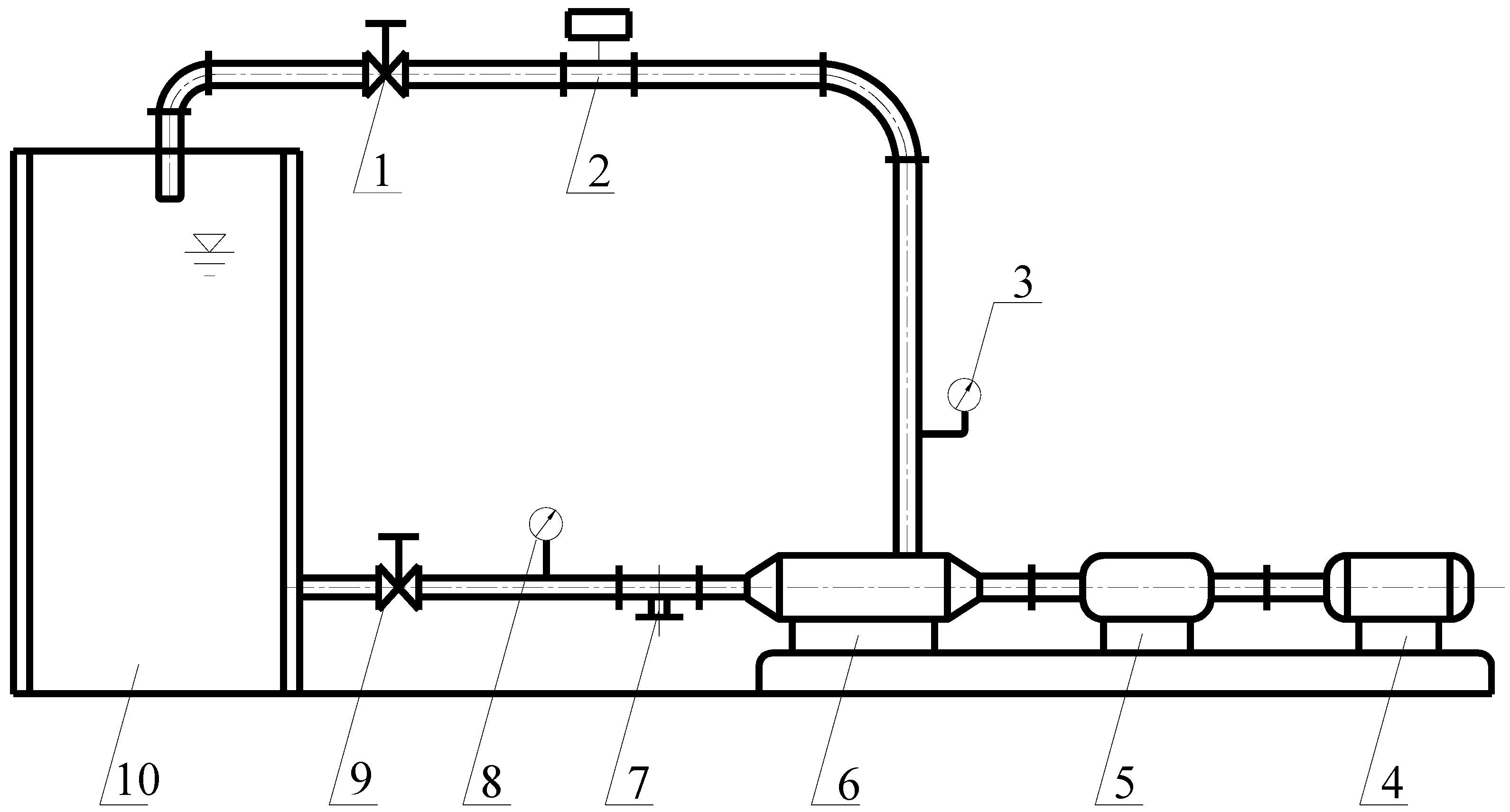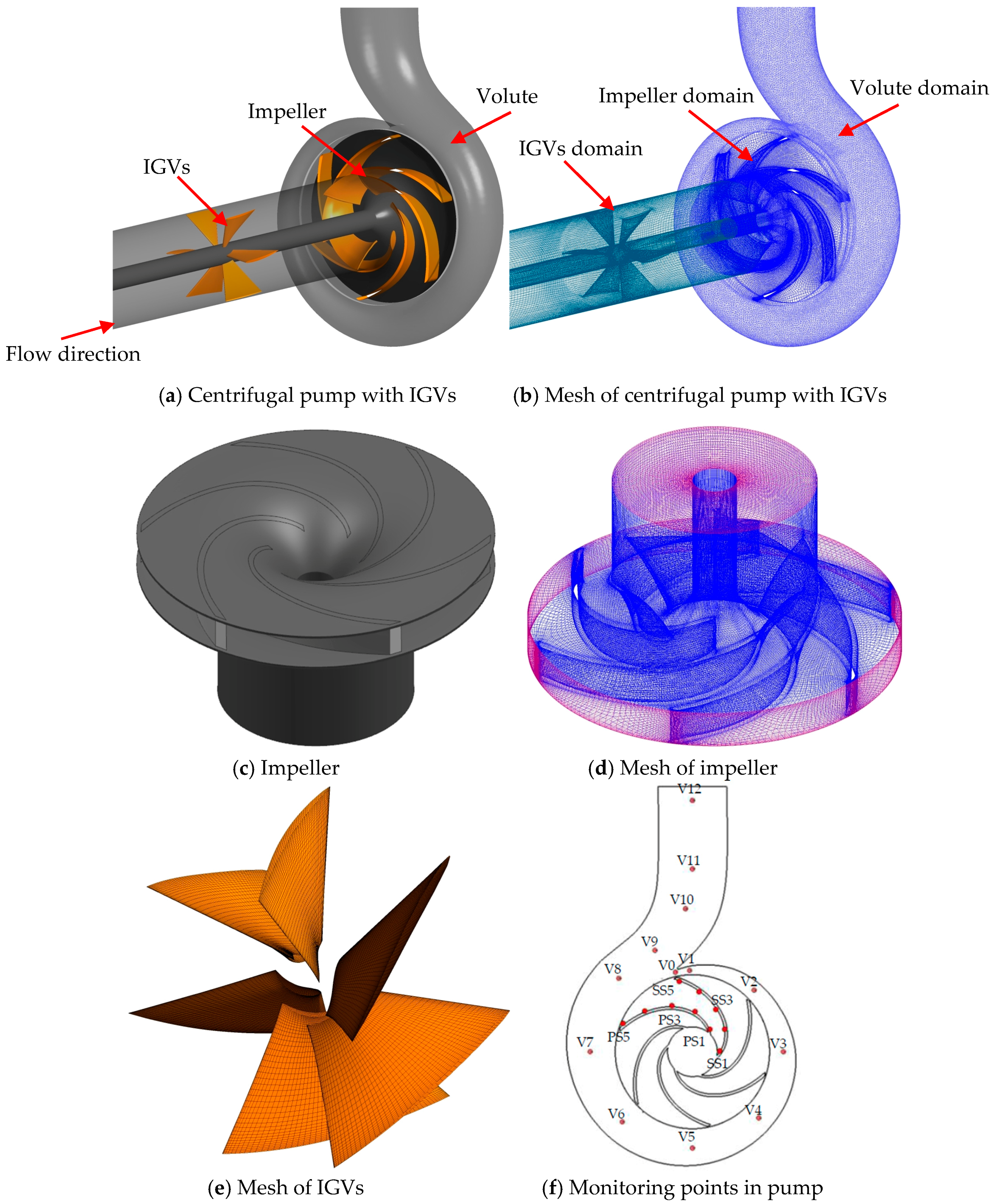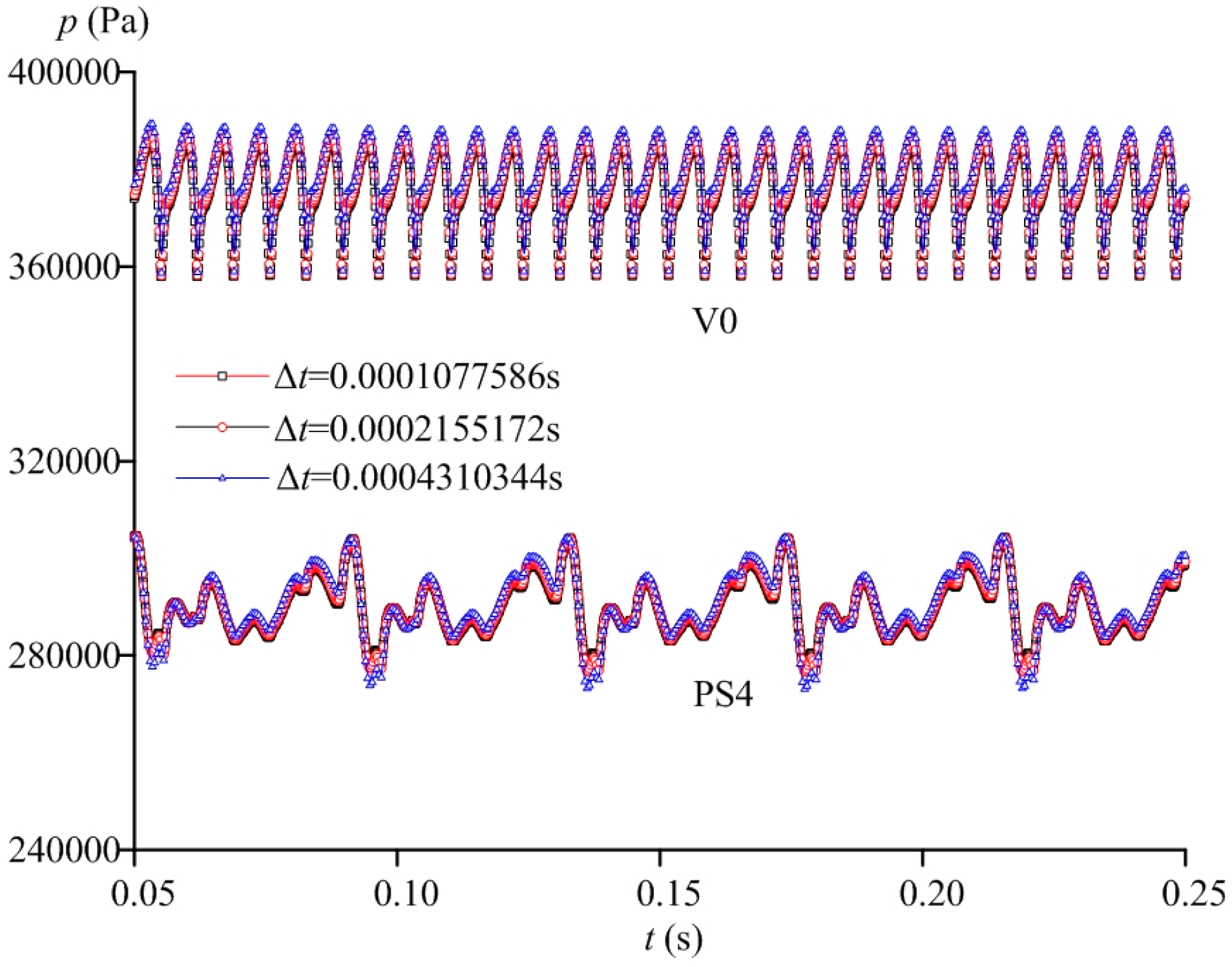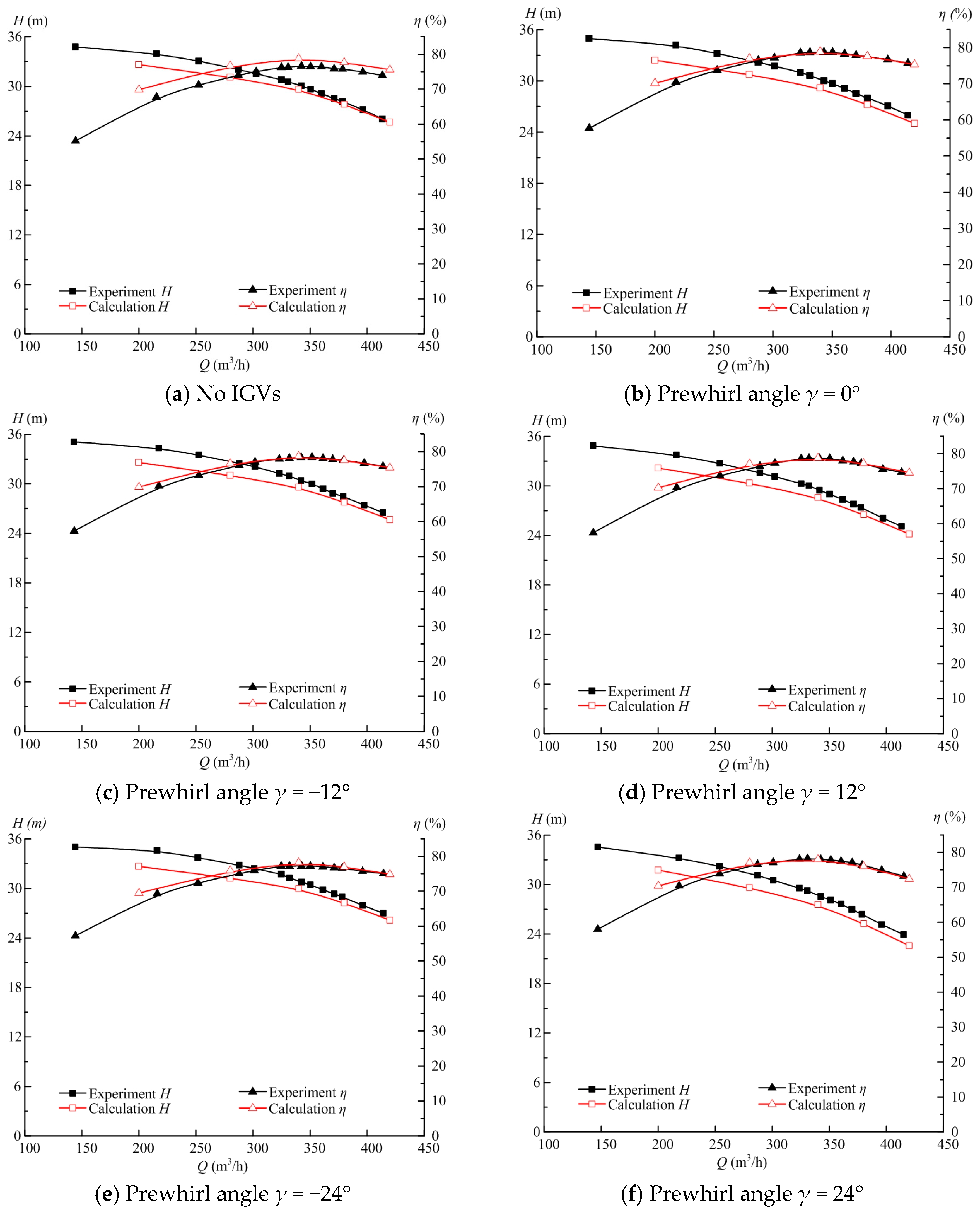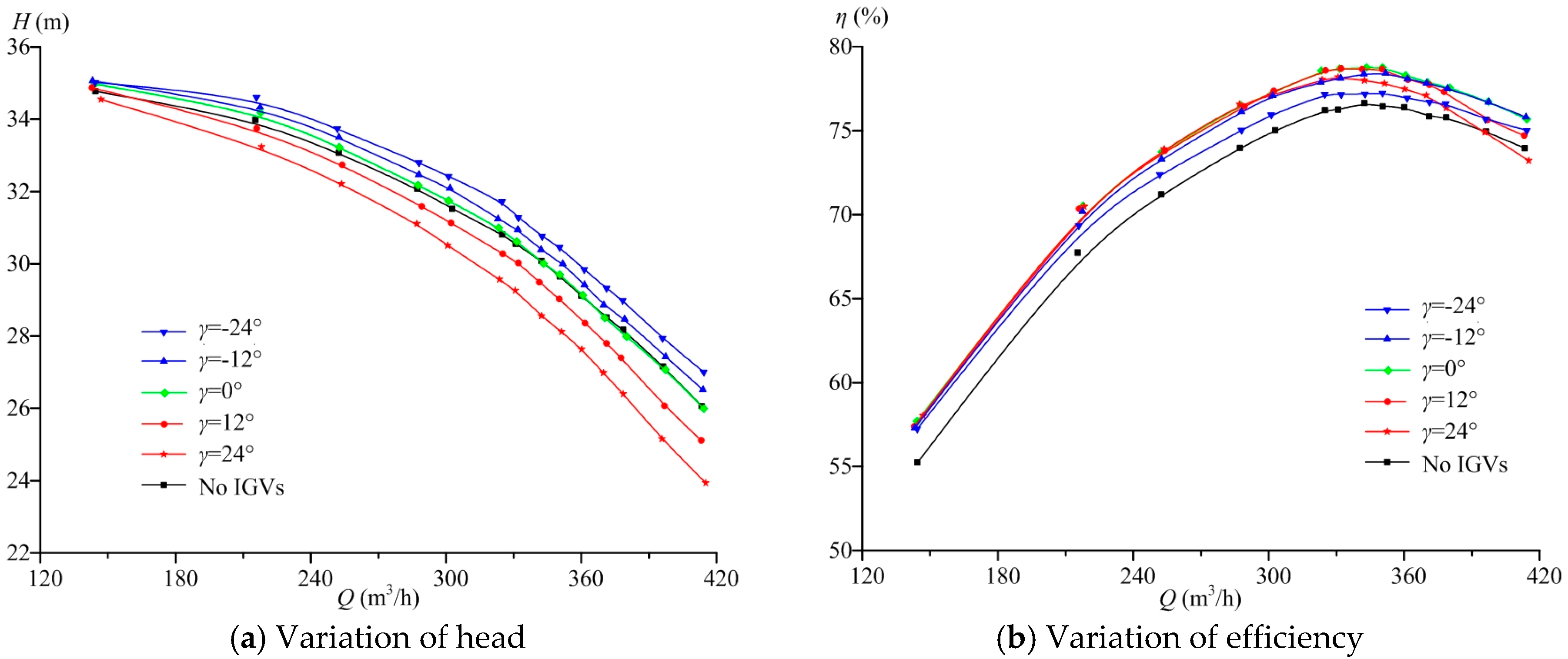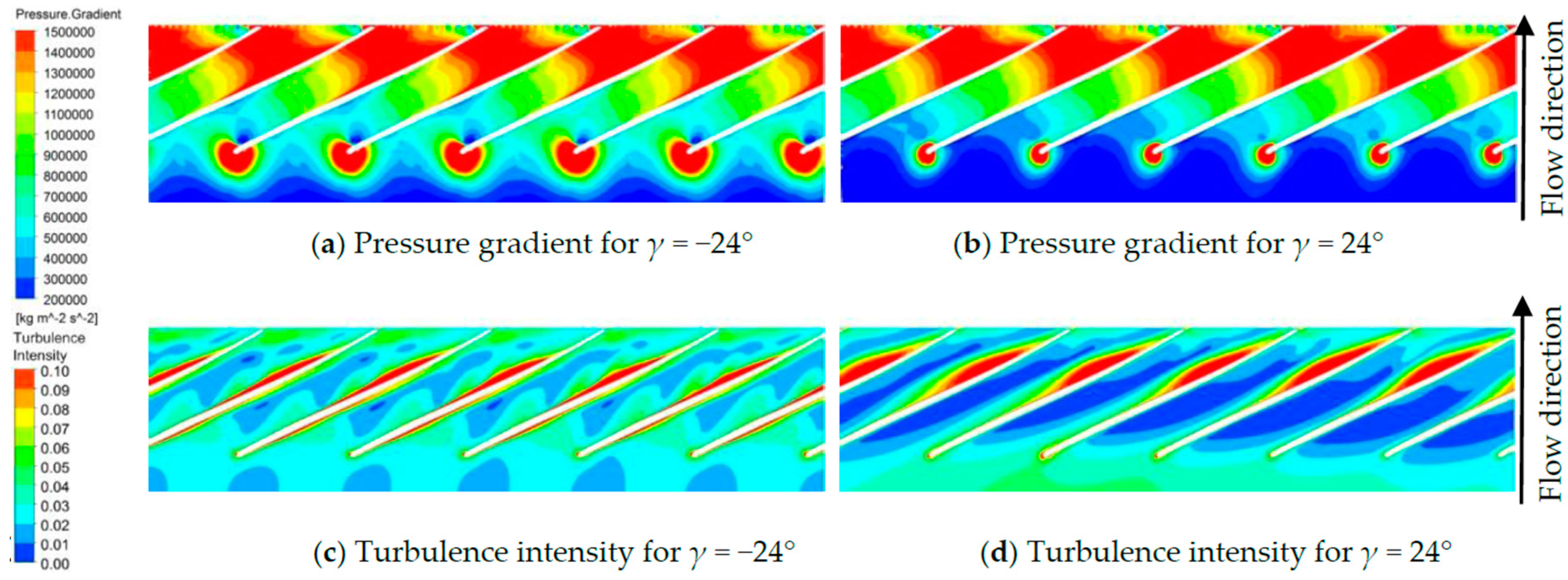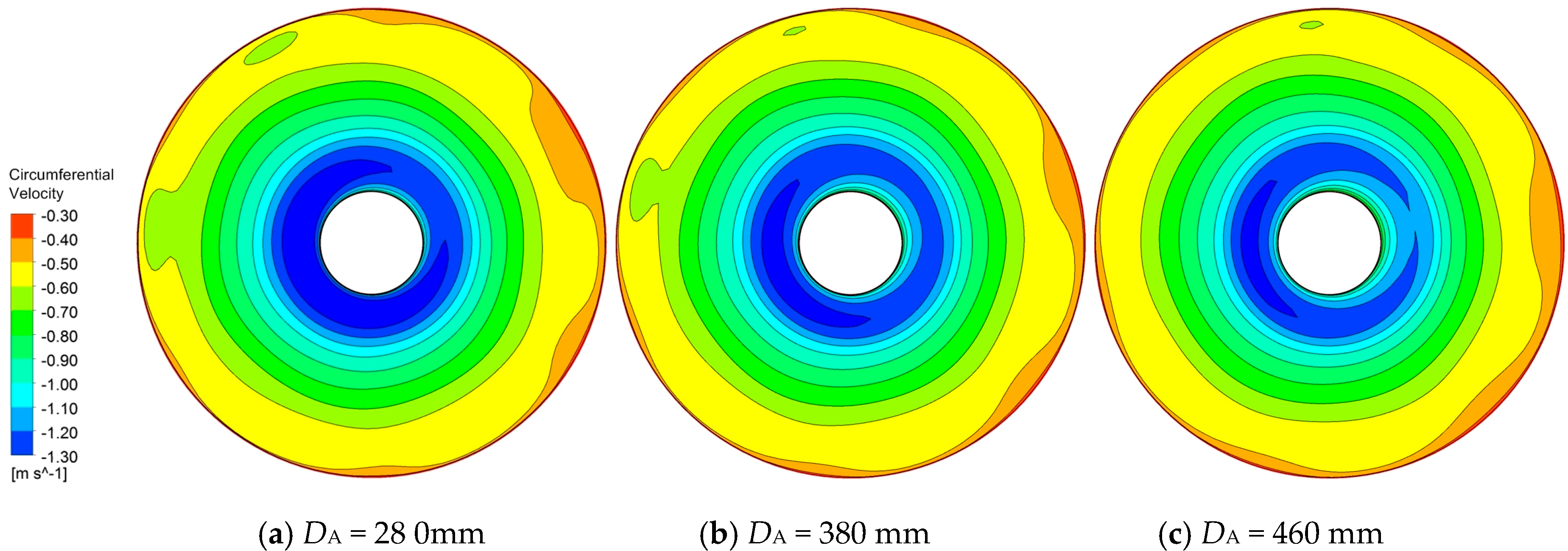4.2. Influence of Prewhirl Angle of IGVs on Pump Performance
Figure 5 shows the variation of head and efficiency for the centrifugal pumps without IGVs and with IGVs for five prewhirl angles with the axial distance of 380 mm. With the prewhirl angle decreasing from 24° to −24°, the pump head dramatically increases at all flow rates, which demonstrates the pump head is significantly influenced by the prewhirl angle
γ. The reason is that when the prewhirl angle decreases from a positive angle to a negative angle, the circumferential velocity at the impeller inlet will also decrease from a positive value to a negative value, thus causing the increase of the pump head according to the Euler equation.
It can be illustrated from
Figure 5b that all efficiencies of pumps with prewhirl regulation are higher than that without IGVs when the flow rate is below 380 m
3/h. For low flow rates below 280 m
3/h, the efficiencies of pumps with positive prewhirl angles are higher than those with negative prewhirl angles. However, for large flow rates beyond 360 m
3/h, the efficiencies of pumps with positive prewhirl angles are lower than those with negative prewhirl angles. The reason is that, at low flow rates, the positive prewhirl suppress the second flow in impeller, and improve the pump efficiency.
Figure 6 shows the pressure distribution and surface streamlines on a circumferential section of
D = 200 mm in a blade-to-blade passage at
Q = 200 m
3/h. It can been seen that the pressure at the section for
γ = −24° is higher than that for
γ = 24°, and this phenomenon corresponds with the pump heads for different prewhirl angles. There is an obvious second flow at this section, and the intensity of the second flow is suppressed when the prewhirl angle turns from
γ = −24° to
γ = 24°, while at large flow rate the impact loss of IGVs with positive prewhirl angles greatly increases, and then reduces the effect of prewhirl regulation on pump efficiency.
Generally, IGVs can significantly increase the energy performance of the centrifugal pump, and the effect is strongly influenced by the prewhirl angle. By changing the prewhirl angle at different flow rates, the efficient operation range of the centrifugal pump can be effectively broadened.
To reveal the flow details in pumps without and with IGVs, the three-dimensional vortex defined by the
Q criterion is presented in the downstream view in
Figure 7 and
Figure 8, based on the simulation results at the designed flow rate. The
Q criterion is the second invariant of the velocity gradient tensor, which is defined as
. Compared with the centrifugal pump without IGVs, the vortex intensity significantly decreases and the vortex distribution is more uniform in pumps with prewhirl regulation. When the prewhirl angle decreases from 24° to −24°, the vortex core region gradually increases on the blades, as well as in the vicinity of the blade leading edge, while the vortex intensity in the suction pipe decreases at first, and then increases with a relative range. The above analysis indicates that, with the consideration of vortex intensity in the impeller and suction pipe, prewhirl regulation with IGVs remarkably optimizes the flow pattern in the impeller and makes it more homogeneous, which explains the efficiency improvement at the designed flow rate, as shown in
Figure 5b. For different prewhirl angles, the positive prewhirl shows better optimization effects than the negative prewhirl, but the increase of the positive prewhirl angle also leads to greater energy loss on the guide vanes. Consequently, comprehensively considering the energy loss in the impeller and suction pipe, the pump with prewhirl regulation of
γ = 0° reaches the highest efficiency at the designed flow rate, as shown in
Table 3.
Taking the steady calculation results as the initial flow field, the transient simulation under the designed flow rate is conducted for 12.5 impeller revolutions. The data of the last 10 revolutions is used to construct the fast Fourier transform (FFT), so the frequency characteristics of the pressure fluctuations on the monitoring points are obtained.
Table 4 shows the dominant frequencies and maximum amplitudes of the pressure fluctuations on the monitoring points in the impeller and volute. It can be seen that all frequencies of the pressure fluctuations for pumps without and with IGVs are the integer times of the impeller rotating frequency
fi, demonstrating that the impeller rotation and the rotor-stator interaction between the impeller and volute are the crucial factors for the frequency characteristics of the pressure fluctuations.
Except for
γ = 24° on SS1 and SS3, the dominant frequencies of the pressure fluctuations on the blade are all the same for pumps with and without IGVs. Compared with pumps without IGVs, the maximum amplitudes of the pressure fluctuations on PS1, SS1, and SS3 in pumps with IGVs significantly decrease, with maximum drops of 69%, 89%, and 58%, respectively. For all pumps without and with IGVs, the dominant frequencies on PS3, PS5, and SS5 remain the same, and the variation of maximum amplitudes is very small. For different prewhirl angles, the maximum amplitudes on PS1 and SS3 at
γ = −24° are larger than those at
γ = 0° and
γ = 24°, which can be attributed to the interaction between the negative prewhirl regulation and the positive rotation in the impeller. For
γ = 24°, the dominant frequencies on SS1 and SS3 change to 2
fi and 5
fi, which are related to the strong positive prewhirl effect shown in
Figure 7d. The above analysis indicates that prewhirl regulation makes the flow state at the impeller inlet more homogeneous and further optimizes the pressure fluctuation characteristics on the blade. The influence of the prewhirl angle on pressure fluctuations is related to the interaction between the prewhirl effect at the impeller inlet and the impeller rotation.
For pressure fluctuations on V1, V3, V5, V7, and V9 in the volute, the dominant frequencies are all 6fi, which is the blade passing frequency. Similar with PS3, PS5, and SS5, the maximum amplitudes on monitoring points in the volute nearly remain unchanged, demonstrating that the influence of the prewhirl angle on pressure fluctuations in the volute is very slight. It can be concluded that the influence level of prewhirl regulation and prewhirl angle on pressure fluctuations decreases from the leading edge of blade to the volute for the centrifugal pump.
To evaluate pressure fluctuation energy in the pumps with and without IGVs, the RMS method is applied in Equations (1) and (2):
where
N is the sample number,
Pi is the pressure at each time step, and
is the mean value of pressure.
Based on 1920 data points in the last 10 revolutions of the numerical simulation, the pressure RMS values in the unsteady calculation are obtained.
Table 5 shows the pressure RMS values on monitoring points in the impeller and volute of pumps with and without IGVs. The variation trends of the pressure RMS values in pumps with different prewhirl angles are similar with those of the maximum amplitudes of pressure fluctuations in
Table 4. Compared with pumps without IGVs, the pressure RMS values on PS1, SS1, and SS3 in pumps with IGVs decrease by 58%, 83%, and 43%, respectively. This shows that the IGVs significantly weaken the pressure fluctuation energy in the pump.
Figure 9 shows pressure gradient and turbulence intensity distribution on blade-to-blade surfaces in the middle span of the impeller. The turbulence intensity, also often referred to as turbulence level, is defined as:
where
k is the turbulence kinetic energy and
U is the mean velocity. Through the user-defined function in CFX 14.5, the turbulence intensity
I is defined according to Equation (3), thus, the turbulence intensity distribution in the pump is obtained.
Compared with
Figure 9a, the low pressure gradient regions in
Figure 9b extend along the flow direction and the high pressure gradient regions near the leading edge significantly decrease, demonstrating that the pressure gradient in an impeller with a positive prewhirl angle is much lower than that in an impeller with a positive prewhirl angle, especially for regions near the leading edge of the blade. As
Figure 9c,d show, the turbulence intensity on the whole blade suction side and blade surface side near the leading edge dramatically decreases when the prewhirl angle changes from −24° to 24°, illustrating that the unsteady flow field in regions near the leading edge of blade for
γ = 24° is more disordered than that for
γ = −24°. It can be concluded that a positive prewhirl angle produces greater optimization effects on the flow state in the impeller than a negative prewhirl angle at the designed flow rate, and the optimization of the flow field around points PS1, SS1, and SS3 significantly reduces the pressure fluctuation amplitudes, as shown in
Table 4 and
Table 5.
4.3. Influence of Axial Distance on Pump Performance
The axial distance DA is defined as the distance between the central line of IGVs and the impeller inlet. To investigate the influence of the axial distance on the energy performance and pressure fluctuation in pumps with IGVs, the steady and unsteady simulation under the designed flow rate are conducted in the present work.
Table 6 shows the comparison of pump efficiencies with axial distances of 280 mm, 380 mm, and 460 mm. The experimental results show that the highest efficiencies of pumps with different axial distances are 78.410% at
DA = 280 mm for
γ = −12°, 78.760% at
DA = 380 mm for
γ = 0°, and 78.560% at
DA = 460 mm for
γ = 0°. The simulation results show that the highest efficiencies are 78.871% at
DA = 280 mm for
γ = 0°, 78.894% at
DA = 380 mm for
γ = 0°, and 78.877% at
DA = 460 mm for
γ = 0°, respectively. Therefore, the axial distance of 380 mm is the recommended axial distance for the present centrifugal pump and IGVs.
Figure 10 shows circumferential velocity distribution at the impeller inlet with different axial distances for
γ = 0° at the designed flow rate. Due to the positive prewhirl effect for
γ = 0°, the value of the circumferential velocity is negative, meaning that the rotation direction of the fluid is the same as the impeller rotation direction. For
DA = 280 mm, the flow at the impeller inlet is not homogeneous enough at the impeller inlet compared with
Figure 10b,c, which may lead to the disordered flow state in the impeller. For
DA = 460 mm, the fluid viscosity through the long suction pipe decreases the velocity circulation at the impeller inlet, thus weakening the prewhirl effect, as shown in
Figure 10c. Therefore, the axial distance of 380 mm is a proper choice to improve the energy performance of the centrifugal pump with IGVs.
To study the pressure fluctuations for different axial distances, the unsteady simulation under the designed flow rate is carried out, and the frequency characteristics of the pressure fluctuations are obtained by the fast Fourier transform.
Table 7 shows the dominant frequencies and maximum amplitudes of pressure fluctuations on monitoring points on the impeller blade and in the volute. The results show that, for different axial distances, the dominant frequencies of pressure fluctuations on most monitor points remain the same, and the variation of the maximum amplitudes on PS3, PS5, and SS5 is very slight. The maximum amplitudes of pressure fluctuations on PS1, SS1, and SS3 gradually decrease when the axial distance increases from 280 mm to 460 mm, indicating that the influence of the axial distance on pressure fluctuations in the impeller concentrates on the region near the blade leading edge. For PS1, on the blade leading edge of the pressure side, the maximum amplitude of the pressure fluctuation reduces from 1697 pa to 1111 pa in a drop of 35%. This can be attributed to the decrease of the axial distance leading to the deterioration of the homogeneous degree at the impeller inlet and further influences the flow pattern in the impeller, as shown in
Figure 10.
As
Table 7 shows, both the dominant frequencies and maximum amplitudes of pressure fluctuations in the volute nearly remain unchanged with the increase of the axial distance, demonstrating that the influence of the axial distance on pressure fluctuations in the volute can be neglected.
The above analysis shows that the influence of the axial distance on pressure fluctuations in the centrifugal pump decreases from the leading edge of the blade to the volute. The axial distance of 460 mm is most beneficial to reduce the pressure fluctuations in the pump, but the influence level and action area are quite limited, especially for DA = 460 mm and DA = 380 mm. Therefore, the axial distance of 380 mm is the comprehensive optimal selection for the centrifugal pump with IGVs, with the consideration of energy performance and operation stability.
